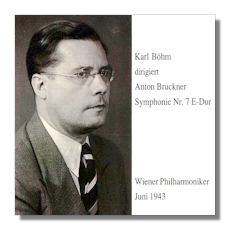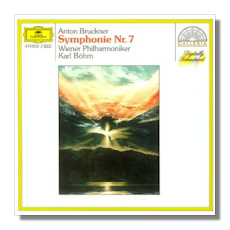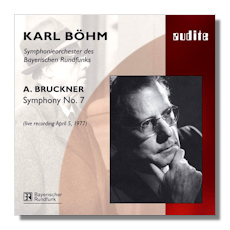
The Internet's Premier Classical Music Source
Related Links
- Bruckner Reviews
- Latest Reviews
- More Reviews
-
By Composer
-
Collections
DVD & Blu-ray
Books
Concert Reviews
Articles/Interviews
Software
Audio
Search Amazon
Recommended Links
Site News
 CD Review
CD Review
Anton Bruckner

Symphony #7
June 1943, Guttman Edition
Vienna Philharmonic Orchestra/Karl Böhm
Preiser CD 90192


September 1976, Nowak Edition
Vienna Philharmonic Orchestra/Karl Böhm
Deutsche Grammophon Galleria CD 419858-2


May 1977, Nowak Edition
Bavarian Radio Symphony Orchestra/Karl Böhm
Audite CD 95.494
Although not terribly celebrated as a Bruckner conductor, Karl Böhm left a relatively substantial recorded legacy, with 24 surviving recordings of the 3rd, 4th, 5th, 7th, and 8th symphonies. Böhm's lyrical and expansive approach to Bruckner is probably best suited to the 7th symphony, which was certainly the symphony of which we have the best recorded legacy. There are 2 surviving performances of the Guttman edition, including the 1943 performance reviewed here, and 9 of the Nowak edition, including the 1976 studio recording for Deutsche Grammophon and the 1977 live performance preserved in excellent sound by Audite.
It is interesting to compare the evolution of Böhm's interpretation from the war years to the two performances when he was already over 80. The timings are very informative. The 1943 Adagio stretches for a very lengthy 27.36, while the DG and Audite discs come in at 24.04 and 22.15 respectively. At the same time, the finale is significantly shorter in 1943 (10.37, as opposed to 12.03 and 12.04). It is characteristic of Böhm's 7th symphony interpretations that the Adagio is typically longer than the scherzo and finale combined, but the contrast in 1943 is remarkable. I am not convinced that this extreme architecture works. There are several moments when the Adagio seems about to grind to a halt, and the relatively aggressive approach to the finale distorts the pacing required for the movement not to seem lightweight after the monumental Adagio and what amounts to a second slow movement in the Trio of the 3rd movement. The sound from the 1943 recording is perfectly acceptable, but it would be difficult to recommend the performance for more than historical interest.
Böhm's interpretation is much more secure in the 1970's recordings. The balance between the movements works much better architecturally and the sound quality allows the finer points of Böhm's approach to come across, in both the live and studio performances. Böhm is a master at shaping Bruckner's melodic line – as can be appreciated from the opening bars of the Adagio in both performances. He is also highly skilled at bringing out the complex texture of Bruckner's orchestration. The coda to the first movement illustrates this nicely both live and in the studio.
The 1976 studio performance is marked by very sensuous string playing and great delicacy from the wind sections. The Adagio is well-paced, and the coda displays the VPO beautifully. However, the climax falls a little flat (due not least to a rather subdued percussion section) and the movement lacks the emotional engagement of the live performance, which I found more convincing overall. The Audite sound is good enough to bring out Böhm's distinctive lyricism. At the same time, the live performance has a sharper edge and greater drive, with a more compelling vision of the architecture of the 7th. The Audite disc is highly recommended.
Copyright © 2012, José Luis Bermúdez





















